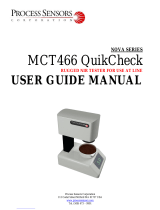
miniLiquid ● Color and Turbidity in Liquids
Quick Start Guide • PUBLIC
QG000121 • v1-00 • 2018-Sep-11
8 Start-Up MiniLiquid
Check the assembly of all mechanical parts, light source and sensor. Plug in the cuvette with the
probe. Seal the holder by using the cover. Connect the light source to power supply and the
sensor via USB to the PC. Switch on all and wait 30 minutes to get working temperature.
To get a stable test system, use one sample from the test series for the next partial step. Select
the parameters in the test software (select gain and integration time) and start the measurement in
such a way that stable values as sensor result greater than 10,000 digits and more are achieved.
Measure over a period and optimize the test system by excluding interfering sources until stable
values are established without noise.
Check the dynamic of the selected parameters with the darkest (e.g. 100% concentration) and
lightest (0% concentration) probe. If the selected parameters are not able to measure the full
target then use a dynamic gain. In this case, check the linearity of the sensor conversion
parameters before and work with calculated results no-depend on these parameters (e.g. basic
counts). Check also non-linearity and drifts over temperature to be able to correct the measured
counts.
For more information about the sensors, please see the data sheets and/or application notes.
Figure 11 :
LED - Sensor Long-Time Test to See Stability (700 steps)




















